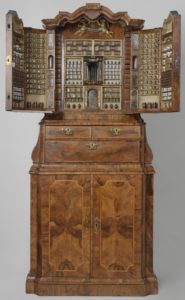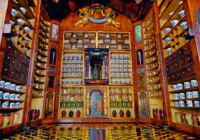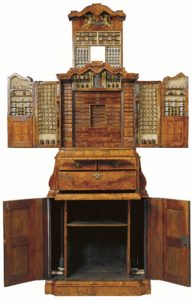 If the shamelessly indulgent excess of Baroque pietre dure cabinets are too ostentatious for your tastes, the Rijksmuseum has an alternative for you: an 18th century collector’s cabinet that opens into a miniature apothecary shop complete with every Barbie Dream Apothecary Shop accessory you could possibly conceive of in your nerdiest of fantasies.
If the shamelessly indulgent excess of Baroque pietre dure cabinets are too ostentatious for your tastes, the Rijksmuseum has an alternative for you: an 18th century collector’s cabinet that opens into a miniature apothecary shop complete with every Barbie Dream Apothecary Shop accessory you could possibly conceive of in your nerdiest of fantasies.
It doesn’t have the glorious riot of colors and patterns you see in the hard stone inlay, but by no means was this a modest piece. About eight feet high and three feet wide and deep, the cabinet is made of oak and pine wood with veneers of walnut and olive wood, plus shell and ivory inlays and gold-plated copper accents. When its doors and drawers are closed, the cabinet looks like a handsome piece expertly built out of fine woods. The way the veneers are cut and installed to create Rorschach-like complex symmetrical patterns attest to the craftsman’s skill before you even get a glimpse at the spectacular interior.
It’s divided into the three horizontal sections. On the bottom is a wide, deep two-door closet in which important books and larger items in the collection were kept. The middle section consists of three drawers, two small ones above one large one the full width of the cabinet. The top is another two-door closet, smaller than the bottom level and unlike the veneered ones below, these doors are mirrored.
 It’s the mirrored doors that open to reveal the plethora of cubbies, drawers, shelves, bottles and more than 300 Delftware jars that are so instantly recognizable as an apothecary’s shop. The scale is so accurate that when you look at the open cabinet without seeing the rest of the cabinet, it looks like you could walk right in and buy all the basil, dried scorpion, mummy flesh and Mithdridatum you need. (All of those materials are listed on the labels of the Delft pots, btw.) There’s even a faux tiled floor made with inlaid wood veneers that looks totally real.
It’s the mirrored doors that open to reveal the plethora of cubbies, drawers, shelves, bottles and more than 300 Delftware jars that are so instantly recognizable as an apothecary’s shop. The scale is so accurate that when you look at the open cabinet without seeing the rest of the cabinet, it looks like you could walk right in and buy all the basil, dried scorpion, mummy flesh and Mithdridatum you need. (All of those materials are listed on the labels of the Delft pots, btw.) There’s even a faux tiled floor made with inlaid wood veneers that looks totally real.
Painted panels on both sides of the central wall represent the medical motif. The top left painting depicts Apollo, Greek god of healing, standing on a pedestal inscribed “Ars longa” (art is long). His counterpoint on the right side is the grim skeletonized figure of death holding his scythe, standing on a pedestal inscribed “Vita brevis” (life is short). Life and death are the stocks in trade of the medical professional, then as now, and the phrase “Ars longa, vita brevis” is a Latinized version of an aphorism written by the Greek physician Hippocrates, the Father of Modern Medicine. The most prominent painted panel is the one on the center bottom in which a doctor examines a urine flask (which is a large part of what doctors did back then, other than read ancient sources). The painting to the right of this is a pharmacology student cooking something up in the lab; to one to the left is a room filled with books. They’re depictions of the practical, hands-on work, the book learning and the staring at pee that symbolize the broader medical profession, including pharmacology.
A pair of gilded putti hover at the top of the central wall. Above their heads they hold up a crown made of medicinal plants and in their other hands, a draped banner which bears the motto “Pietas, scientia, temperantia, vigilantia, et studium assiduum ornant pharmacopceum” (piety, knowledge, temperance, vigilance and assiduous study are ornaments to the pharmacist). The left, central and right walls of the miniature shop are covered head to toe with pharmacological specimens, each to its own, often labeled, jar or drawer. The Delft jars, some with spouts, others smooth-lipped, are all custom-made to fit the shop. There are dozens of them, each painted with their own label.
 But no self-respecting cabinet would lay it all out there. Hidden compartments are a must, and this cabinet is no exception. The back “wall” of the shop conceals 56 more drawers, each divided into multiple compartments. Only five of them are empty. The rest still contain specimens of almost 2,000 plants, seeds, animal body parts, minerals, rocks and fossils, all deemed to have medicinal use back then. The whole back wall slides up to reveal its secret cache of drawers.
But no self-respecting cabinet would lay it all out there. Hidden compartments are a must, and this cabinet is no exception. The back “wall” of the shop conceals 56 more drawers, each divided into multiple compartments. Only five of them are empty. The rest still contain specimens of almost 2,000 plants, seeds, animal body parts, minerals, rocks and fossils, all deemed to have medicinal use back then. The whole back wall slides up to reveal its secret cache of drawers.
The maker of this masterpiece is unknown. Researchers have discovered that the cabinet was made around 1730 in Amsterdam, and the combination of quality materials, intensive attention to detail and the specificity of the pharmacological motif indicates this was a very expensive custom-made piece of furniture commissioned by a wealthy doctor or pharmacist. In the 18th century, the Dutch bourgeoisie, flush with profits from flourishing trade and business, enjoyed the conspicuous consumption the aristocracy had always indulged in, but put their own stamp on it. Instead of making collector’s cabinets that looked like church facades inlaid with a multitude of the hardest, most prized semi-precious stones, the kind of thing popes and princes were into it, the businessmen sought to create luxury versions of their own environments. What better way for a medical man to show off his collection of animal, vegetable and mineral specimens than in a cabinet that looks like a dollhouse version of his flawlessly appointed shop?
 The Rijksmuseum acquired the cabinet in 1956, but it has very seldom been on display. It needed a great deal of study and conservation before it could be stabilized for its own safety and those of visitors. More than 50 experts were involved in this research project, and good thing too, because they found samples of uraninite and two other uranium-heavy minerals that had to be locked up in lead boxes and put into storage in accordance with the regulatory provisions of the Dutch Nuclear Energy Act.
The Rijksmuseum acquired the cabinet in 1956, but it has very seldom been on display. It needed a great deal of study and conservation before it could be stabilized for its own safety and those of visitors. More than 50 experts were involved in this research project, and good thing too, because they found samples of uraninite and two other uranium-heavy minerals that had to be locked up in lead boxes and put into storage in accordance with the regulatory provisions of the Dutch Nuclear Energy Act.
The cabinet has now been conserved and has gone on display in the Rijksmuseum’s 18th century gallery. It is the only known 18th century miniature apothecary’s shop in the Netherlands, and will be displayed fully open so visitors can enjoy the cabinet in all its detail. The results of the research project has been published in a large-format book — so large the photographs capture the miniatures almost in real size — which can be preordered on Amazon (cost: $60) or purchased directly from the Rijksmuseum’s online store (cost: €40) starting July 3rd.
An excellent peace of furniture, even if I am personally a bit unsure of what the idea behind it could have been.
To me, it looks like some form of ‘masterpiece’ that a would-be ‘master cabinetmaker’ would have made -in order to demonstrate his mastery and, thus, be a recognized as a ‘master’ in the guild of cabinetmakers.
Moreover, in my hometown they recently closed down a drugstore that had been established in 1733, and the oldest one still in existence had opened in 1696: Of course, they all have bigger drawers.
I agree that the cabinet was made c1730 in Amsterdam for a wealthy patron, given the quality materials and the custom-made pieces of furniture. But imagine the poor young craftsmen who might have lost their eye sight or their finger tips, creating the perfect final product.
You have a typo in your Amazon link: (.come instead of .com)
Oh my goodness, my childhood dreams of dollhouses stuffed with *everything*! That is some amazing work.
I wonder what one would do with mummy flesh …
Hard to tell what the idea behind ‘mum(m)ia’, or ‘pulvis mumiae’ could have been. My own father, however, used an anti dandruff shampoo that he imported from the US – and that stuff had a really awful stench of tar. Allegedly, ‘mumia’ was used against almost everything.
Ideas about general medicine and pharmacy changed over time, and -first of all- raisin, tar, bitumen, honey (or ‘whatever’) played a certain rule. Some of the stuff was used for mummification and/or hard to come by in the West. Also, ‘mumia’ was used as color pigment
Then, there is dried up flesh (ground up to powder), voodoo, magic and ‘TCM’: Visit a shop for TCM and you can get -powdered or not- almost every plant, mineral or creature in the world. Some is -at best- ‘placebo’, but occasionally there is a substance contained with a ‘real’ effect.
:hattip:
Hard to tell what the idea behind ‘mum(m)ia’, or ‘pulvis mumiae’ could have been. My own father, however, used an anti dandruff shampoo that he imported from the US – and that stuff had a really awful stench of tar. Allegedly, ‘mumia’ was used against almost everything.
Ideas about general medicine and pharmacy changed over time, and -first of all- raisin, tar, bitumen, honey (or ‘whatever’) played a certain rule. Some of the stuff was used for mummification and/or hard to come by in the West. Also, ‘mumia’ was used as color pigment
Then, there is dried up flesh (ground up to powder), voodoo, magic and ‘TCM’: Visit a shop for TCM and you can get -powdered or not- almost every plant, mineral or creature in the world. Some is -at best- ‘placebo’, but occasionally there is a substance contained with a ‘real’ effect.
:hattip:
That is EXQUISITE! :love: I want to put it in my living room and put all my favorite books in the bottom and my tiniest trinkets in the top.
I bet it smells amazing, too. That lovely wood, and all the different specimens. Sniffing it might kill you, given the toxic things within, but what a way to go.